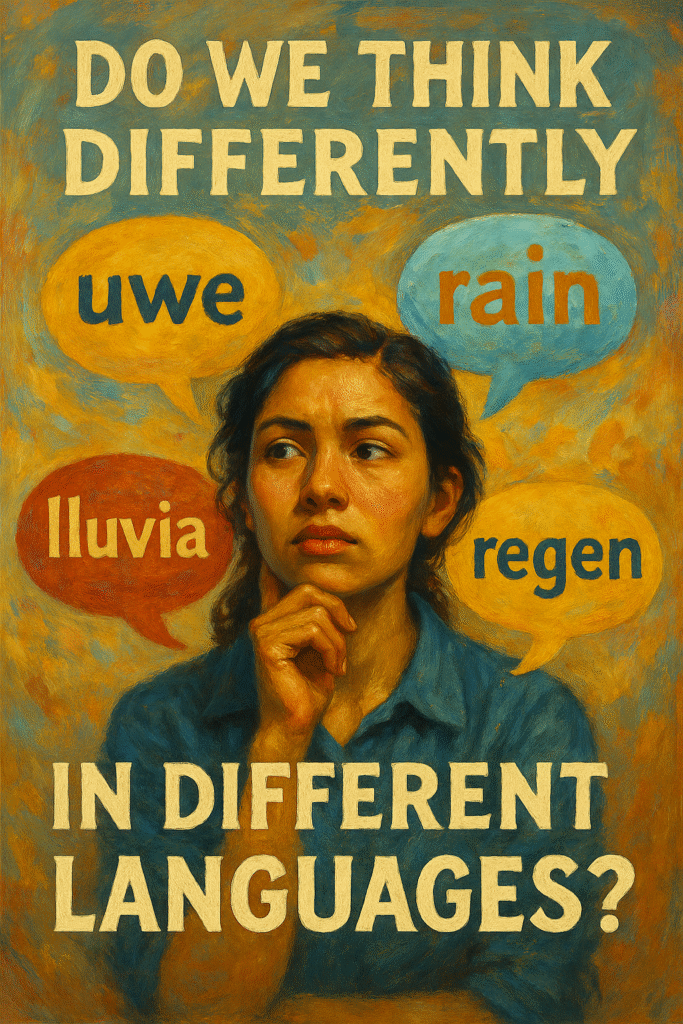Do we think differently in different languages? This question lies at the heart of cognitive linguistics, a field exploring how language shapes thought, perception, and even creativity. This exploration delves into psychology, philosophy, and cultural influences, offering fascinating insights into the bilingual brain and cross-language cognitive differences.
How Language Influences Thought: The Sapir-Whorf Hypothesis
The Sapir-Whorf Hypothesis, or linguistic relativity, proposes that language structure and vocabulary influence our worldview. For example, the many Hawaiian terms for rain might heighten rain perception compared to English speakers. This illustrates how language and perception differences can arise. Additionally, the hypothesis suggests that speakers of different languages might perceive the same situation differently based on the linguistic tools available to them. For instance, the lack of a specific future tense in Mandarin Chinese has led researchers to propose that speakers may have a different attitude towards planning and future events compared to those whose languages do have a future tense. (source: Frontiersin)
Further examples can be drawn from the study (How Language Shapes Thought) (Do we think differently in different languages?) of gendered nouns in languages like Spanish and German. In these languages, objects often take on a feminine or masculine connotation, which can lead to different associations and notions of the items described. Researchers found that speakers of gendered languages may describe objects – say, a bridge or a key – with adjectives that reflect cultural stereotypes associated with femininity or masculinity. This creates a distinctive cognitive framework that influences the way speakers think and express themselves about the world. (source: Scientificamerican)
Thinking in a Second Language: Cognitive Flexibility and Creativity
Thinking in different languages, especially for multilingual individuals, affects creative expression and problem-solving. The cognitive switching between languages fosters enhanced creativity and deeper thought processes. For instance, a study conducted at the University of Copenhagen found that bilingual students often performed better on creative problem-solving tasks compared to monolingual peers. Cognitive flexibility, the ability to switch and adapt thinking when faced with new challenges, appears to be bolstered by the experience of managing multiple languages.
One setting where this phenomenon is evident is in the creative arts. Authors like Chimamanda Ngozi Adichie often express how narrating their stories in different languages opens up diverse nuances, allowing for a richer portrayal of character emotions and cultural insights. Similarly, musicians like Shakira leverage her multilingual skills to blend various cultural influences, creating a unique sound that appeals to a broad audience. In both cases, the cognitive frameworks provided by different languages inspire novel artistic directions and expressions.
Scientific Evidence: Language and Thought Relationship
Color Perception and Spatial Orientation: How Language Shapes Thoughts
Studies, like the World Color Survey (WCS), show that richer color vocabularies lead to better color differentiation. Research comparing English and Guugu Yimithirr speakers revealed how different spatial orientation terms (egocentric vs. cardinal directions) influence navigation, showcasing language’s influence on perception. Guugu Yimithirr speakers, for instance, naturally navigate using cardinal directions (north, south, east, west) rather than the typical egocentric frame of reference (left or right), which enhances their spatial awareness and memory of directions.
Moreover, recent studies released through universities have suggested that speakers of languages with multiple color terms, such as Russian, which differentiates between light and dark blue, are better at identifying hues within that spectrum. This illuminates how language can refine our sensory perceptions by emphasizing certain features, ultimately honing our cognitive functions.
Cognitive Switching in Multilinguals: Thinking in Another Language
Research indicates that switching between languages alters cognitive strategies in problem-solving. A classic study by the University of Cambridge demonstrated that bilingual participants reported more creative ideas when they worked through problems in their second language compared to their native tongue. This supports the notion that language can guide our cognitive frameworks. The mere act of utilizing a second language appears to bring about a different perspective, generating variance in cognitive processes and subsequently leading to richer solutions.
Culture’s Role in Language and Thought
Language carries cultural meanings. For example, Japanese emphasizes harmony (“wa”) through indirect communication, while individualistic cultures like the US favor directness. Differences in communication can reveal broader cognitive processing styles embedded within cultures, influencing everything from negotiation tactics to how one conveys disagreement. In a collectivist culture, the willingness to avoid confrontation and preserve group harmony is paramount, repackaging conflict in a manner that aligns with social cohesion.
Additionally, concepts unique to certain cultures offer fascinating insights into cognition and linguistics. For instance, the German word “Schadenfreude” entails a specific feeling of pleasure derived from another’s misfortune, an absence in many other languages. This cultural specificity can influence emotional reasoning and ethical considerations, showing that language intricately weaves into the fabric of societal norms and behaviors.
Multilingual Experiences: Real-World Examples of Language and Cognition
Multilingual individuals offer valuable insights into the cognitive interplay of languages. One reported feeling deeper emotions in Spanish compared to English, claiming the language imbued connections with their heritage. Another multilingual reported experiencing different thought processes depending on whether they used Polish, English, or French, highlighting the distinct emotional and conceptual lens facilitated by each language. These experiences suggest that language not only shapes how individuals communicate with the world but also defines their internal experiences and emotional landscapes.
As noted by cognitive linguist Steven Pinker, “The languages we speak can constrain how we think, but the depth of thought we can convey also depends on the richness of our linguistic repertoire.” This aspect amplifies the significance of multilingualism as a tool for broader cognitive flexibility. As individuals navigate their linguistic repertoires, they can explore various paradigms of thinking and perception.
Multilingualism and Creativity: Language-Driven Creativity
Research suggests multilingualism enhances cognitive flexibility, leading to richer creative outputs. A prominent study highlighted how multilingual artists often draw inspiration from diverse cultural experiences, creating more nuanced works that resonate across different audiences. With the ability to navigate multiple languages, these artists can invoke distinct cultural symbols and ideas, enabling them to develop a universal appeal in their creations.
The power of language-driven creativity can be witnessed through various award-winning films and books, where multidisciplinary storytelling reflects the ideas cultivated through different languages and cultures. Authors such as Junot Diaz, who often blends Spanish and English in his narratives, present a vibrant narrative voice that captures the essence of dual identity and brings forth rich emotional depth.
Conclusion: The Profound Connection Between Language and Thought
The question “Do we think differently in different languages?” leads to exploring the fascinating interplay of language, thought, and culture. From bilingualism and cognition to language and memory, the journey continues to reveal the profound connection between language and our understanding of the world. As researchers dive deeper into this linguistic journey, we can anticipate further insights into how languages shape our cognitive experiences and perspectives.
An essential takeaway is that the cognitive effects of multilingualism can guide educational approaches, language teaching, and even self-development strategies. Emphasizing the power of language awareness can unlock creative potential and broaden cognitive horizons.
FAQ: Language and Thought
Do different languages affect cognitive processes? Yes, they influence perception, memory, and problem-solving in unique ways.
What is the Sapir-Whorf hypothesis? It posits that language influences thought and how we perceive the world around us.
How does multilingualism impact creativity? It enhances creativity through cognitive flexibility, allowing individuals to draw on diverse experiences and cultural insights.
Can language shape emotional expression? Yes, different languages often evoke varying feelings and emotional nuances.
Is thinking in a second language different from thinking in a first language? Often, yes, due to cultural associations, emotional connections, and cognitive processing differences inherent to each language.
What practical steps can I take to enhance my cognitive flexibility through language? Engage in language immersion experiences, practice storytelling in multiple languages, or even journal your thoughts in different languages to explore how your perceptions may shift.
Observing multilingualism not only enriches our individual experiences but also offers a window into how diverse cognitive frameworks shape humanity’s collective understanding of life and interaction with our worlds.


